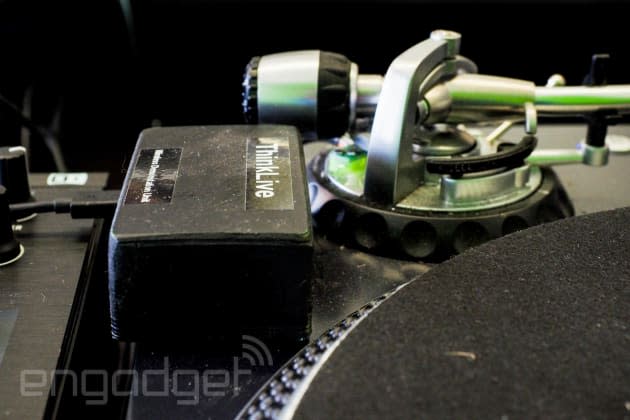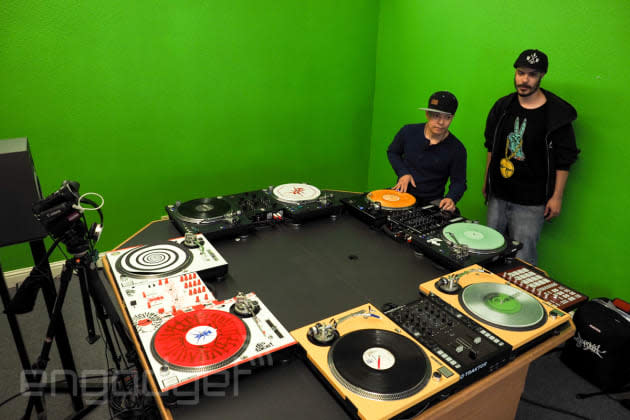The DJs of Silicon Valley who are changing music

Before Silicon Valley had an app for everything, and before the halcyon years preceding the dot-com bubble, Richard Quitevis and Ritche Desuasido were teaming up and making waves in the DJ industry. Disrupting, even. As DJs QBert and Yogafrog, respectively, both came up in the Bay Area mobile DJ scene of the early '80s. In 1996, they formed their own company, Thud Rumble, to help drive their craft forward with affordable gear created by and for DJs. From the early days launching cutting-edge records, to designing mixers for some of the biggest names in music and teaming up with Intel to create low-cost, low-latency instruments, Thud Rumble has had a huge impact on the technology used in the DJ world, all while living in the shadow of larger Silicon Valley companies.
It recently stepped out of that shadow at Maker Faire when it showed off its wares at the Intel booth. Children and adults alike crowded around the Thud Rumble tables for a chance to put on headphones and try out the three instruments developed using the Intel Edison chip: a drum machine, a keyboard and a mixer connected to a turntable. They tapped out beats, scratched records and played that one song they know on the piano. What most of the attendees probably didn't realize is that all those devices have an incredibly low latency of 0.5 millisecond -- something musicians clamor for when playing digital instruments attached to computers. In this regard, latency is the time between a key being pushed or a record scratched and the sound emitting from the speakers. Currently, DJ's with digital gear are routinely adjusting their setups to get between two and seven milliseconds of latency. When you're scratching quickly to the beat, a few milliseconds can throw your timing off. In fact, when a song requires extremely quick scratching, most professionals opt for scratching on analog, skipping the computer all together because digital just can't keep up.

People can't help but want to make music. Give them an instrument and they'll try to play something even if it's for a few moments before giving up. But children -- children will stick around a bit longer.
"We want to make it really focused for the kids," said Desuasido. "We want to develop it more so the kids can get in."
"And at a low-ass price," Quitevis injects from the company's unassuming storefront in Millbrae, California. The office is a reminder of what's at the heart of this empire: the love of a craft that in some clubs has been replaced almost entirely by an app. Turntables, mixers, keyboards and drum machines fill nearly every crevice. In the back of the office lies the Octagon a table where four DJs can scratch, hang out and share tips about their craft. It's communal. Everyone in the office is a DJ in addition to whatever their job title is. Lead Developer Rich Johnson (aka DJ Hard Rich) demoed the Edison-powered mixer by scratching. His love of DJing as a kid ran parallel with his love of developing.
The team found their passion early in life. They want to ignite that same love of music in children with their latest venture. But adult musicians, especially DJs, will also be excited to try out a mixer that stores all their music and tracks in nearly real time. Because the set up doesn't require a computer, Thud Rumble is talking to manufacturers about placing a display directly on the mixer to mimic the UI found in many DJ apps. It would mean the end of dragging a laptop to a show. If multiple DJs are on the bill, you just arrive with a USB stick with your tracks. Or better yet, a platter.

Like the Thud Rumble guys, ThinkLive CEO Charles Spencer is a DJ. But he's also a hardware developer. Spooner created and patented a turntable that houses three sensors to track vinyl, platter and tone-arm movement. It removes the need for vinyl records with timecode to interact with digital audio. The turntable will actually work with any piece of vinyl and track, as well as vinyl with timecode tracks. But it's what it does with that tracking data that's impressive.
Because it's tracking even the slightest movement in near real time, the system outputs a digital scratch waveform of a session. Those waveforms can be used to add different samples and filters, to the audio. If you're recording a mix and the audio feels hollow, you can change the sound attached to the waveform. And like the Edison-powered devices, its latency is lower than systems that go through a computer and mixer. As for DJing, all music would be stored on the platter. Instead of switching out a computer, DJs would just swap out the platter and start scratching. The setup was impressive enough to get the Thud Rumble guys on board as soon as they saw it. When Spooner met with QBert at a recent NAMM, he made if halfway through his PowerPoint presentation when Quitevis stopped him. "This is the future of DJing," he said.

Like DJing itself, the desire to guide the future of the turntables starts with vinyl. Thud Rumble first created records that have a series of samples for DJs. Then the company made that record unskippable, with each track's grooves along the X-axis containing the same repeated sample. That way if the needle jumps out of the groove but still lands on the same track, it will still pick back up at the exact same point. With each new product, Desuasido said they told themselves, "that idea really came to life; let's keep doing this."
Then Desuasido and Quitevis met Japanese musical instrument manufacturer Vestax. "That's when we started designing for a big DJ company and eventually turned them into the main DJ company in the '90s and early 2000s," Desuasido said. The company designed the PMC-05, 06 and 07 series of scratch mixers, which became the industry standard. It also designed the direct-drive Vestax PDX-2000 turntable, which, like the mixers, became an industry standard along with the Technics SL-1200 turntable line.
Eventually Thud Rumble started designing for Pioneer, Native Instruments, Ortofon, Casio and others. QBert started an online DJ school: QBert Skratch University. The company is about to launch its own mixer in partnership with DJ Tech Pro. The TRX will be available at Guitar Center, Amazon and on ThudRumble.com in July. It also has four apps in the App Store and Google Play Store. QBert also released an album and companion animated movie (produced by Yogafrog), which was shown at the Sundance Film Festival. Quitevis and Desuasido's one-stop site for the DJ community sells clothing, slipmats, stickers, DVDs, CDs, cartridges and, of course, vinyl.
It is commerce tied to an earnest enthusiasm for a craft that's tough to find at most startups in Silicon Valley. It's an idea factory where it's not unusual to get texts from QBert or Yogafrog because they thought of something while sitting next to someone on a plane. Those ideas no longer revolve exclusively around DJing. The team is tapping into the technology available now to think about the future. Desuasido says: "We plan to do this with every musical instrument, really. There's so much out there that's untapped."

















